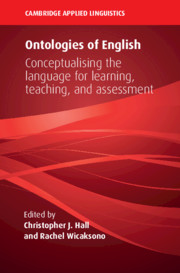Book contents
- Ontologies of English
- The Cambridge Applied Linguistics Series
- Ontologies of English
- Copyright page
- Dedication
- Contents
- Figures
- Tables
- Contributors
- Series Editors’ Preface
- Acknowledgements
- Transcription Conventions
- Part I Introduction
- Part II English in/for L2 Learning and Teaching
- Part III English in Schools
- Part IV Assessing English
- Part V English in Lingua Franca Contexts
- Part VI English and Social Practice
- 15 English as a Resource in a Communicative Assemblage
- 16 Mobile Learners and ‘English as an Additional Language’
- 17 Mobility and English Language Education
- Part VII Commentary and Conclusions
- Index
- References
16 - Mobile Learners and ‘English as an Additional Language’
from Part VI - English and Social Practice
Published online by Cambridge University Press: 24 December 2019
- Ontologies of English
- The Cambridge Applied Linguistics Series
- Ontologies of English
- Copyright page
- Dedication
- Contents
- Figures
- Tables
- Contributors
- Series Editors’ Preface
- Acknowledgements
- Transcription Conventions
- Part I Introduction
- Part II English in/for L2 Learning and Teaching
- Part III English in Schools
- Part IV Assessing English
- Part V English in Lingua Franca Contexts
- Part VI English and Social Practice
- 15 English as a Resource in a Communicative Assemblage
- 16 Mobile Learners and ‘English as an Additional Language’
- 17 Mobility and English Language Education
- Part VII Commentary and Conclusions
- Index
- References
Summary
The number of pupils for whom English is an additional language (EAL) has grown steadily over the past twenty years, increasing by around 300 per cent in England since 1997 (Department for Education, 2018a; NALDIC, 2018a). This linear progression, however, masks wide disparities between groups of pupils and their experiences of education. The large majority are second- or third-generation British citizens born into multilingual homes (Strand and Demie, 2006; Strand, Malmberg and Hall, 2015). English is often their strongest language, so while officially classed as ‘EAL’, it may be more helpful to describe them as ‘multiliterate’ (New London Group, 1996; Datta, 2007) or ‘advanced bilingual learners’ (Conteh, 2012, pp. 12–14), as their different languages play distinct roles in their lives. Others will be new to the United Kingdom, perhaps also new to English and even to formal schooling, but with a set of contextually specific ‘negotiation strategies and a repertoire of codes’ (García, 2007, p. xiii) developed in different settings over time. These learners may have migrated with the intention of settling in the United Kingdom; they may be ‘sojourners’ whose parents are working or studying here for a period of time; or they may ‘transmigrate’, meaning that this is part of a longer migration or that they are regularly resident in a number of countries. Many ‘EAL pupils’ are therefore highly mobile, and such mobile learners are the focus of this chapter.
- Type
- Chapter
- Information
- Ontologies of EnglishConceptualising the Language for Learning, Teaching, and Assessment, pp. 315 - 334Publisher: Cambridge University PressPrint publication year: 2020
References
- 1
- Cited by

